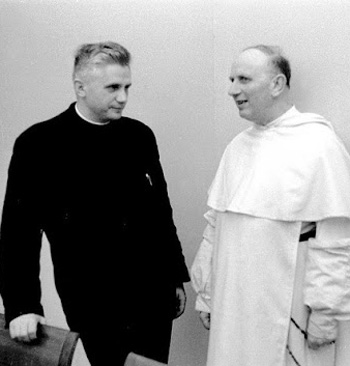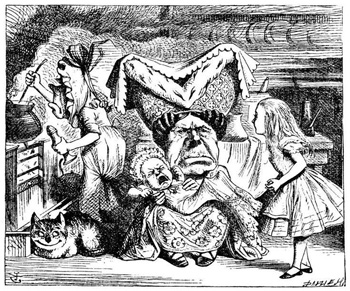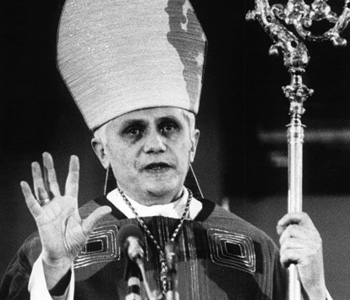Asuntos Tradicionalistas
 |
 |
 |
 |
 |
 |
 |
Misa Dialogada - CXL
Los falsos pretextos de Ratzinger
para rechazar la escolástica
Joseph Ratzinger pensó que el rechazo de la escolástica era “un paso justificado y necesario”1 por los siguientes motivos:
 Dado que todas estas críticas eran el material común de los teólogos progresistas de mediados del siglo XX, está claro que Ratzinger estaba dispuesto a unirse a la campaña de difamación del escolasticismo.
Dado que todas estas críticas eran el material común de los teólogos progresistas de mediados del siglo XX, está claro que Ratzinger estaba dispuesto a unirse a la campaña de difamación del escolasticismo.
Cuando consideramos las razones, enumeradas anteriormente, por las que Ratzinger – en sus propias palabras – “quería salir del tomismo clásico” (aunque nunca estuvo en él) con miras a “entrar en una conversación viva con la filosofía contemporánea”, 11 se sugiere la conclusión de que fue un revolucionario que incitaba a otros también a rebelarse contra el sistema escolástico.
Ejemplos de “control del pensamiento” del Vaticano II
Examinemos cada uno de los puntos de Ratzinger.
 Primero, sus objeciones a la claridad: hace que esta cualidad admirable y esencial suene como algo indeseable y sin valor. Poco después del Vaticano II publicó una obra en alemán sobre la última sesión del Concilio.12 En ella mencionaba los documentos preparatorios que habían sido desechados –principalmente, hay que recordarlo, sobre su propia insistencia, precisamente porque se basaban en el pensamiento escolástico extraído de los Manuales.
Primero, sus objeciones a la claridad: hace que esta cualidad admirable y esencial suene como algo indeseable y sin valor. Poco después del Vaticano II publicó una obra en alemán sobre la última sesión del Concilio.12 En ella mencionaba los documentos preparatorios que habían sido desechados –principalmente, hay que recordarlo, sobre su propia insistencia, precisamente porque se basaban en el pensamiento escolástico extraído de los Manuales.
Paradójicamente, se quejó de que las formulaciones claras expresadas en estos documentos estaban aprisionadas en el núcleo interno del sistema escolástico, de modo que cuanto más brillaban con la luz de la claridad, más perdían contacto con la realidad. Sin embargo, esto no tendría ningún sentido para una persona entrenada en métodos de razonamiento escolásticos. Evitar la claridad es abrir la puerta a la ambigüedad; sin embargo, Dios creó la mente humana específicamente para alcanzar el conocimiento de la Verdad mediante la comprensión de la realidad.
Al leer la publicación de Ratzinger, uno tiene derecho a asombrarse de que un Prelado, que sirvió como Prefecto de la CDF y ascendió al cargo de Sumo Pontífice, represente una situación en la que prevalece lo contrario de lo normal o esperado – esto nos recuerda Las aventuras de Alicia en A través del espejo, y donde la claridad, la objetividad y la verdad deben evitarse, y la realidad sólo es discernible en los términos favorecidos por los teólogos progresistas.
Bien puede decirse que la “Nueva Teología” presenta una imagen de “espejo” de la Iglesia, con todo al revés, ya sean los fines del matrimonio, el estatus del clero y los laicos, lo objetivo y lo subjetivo, o el conjunto del orden cristiano en relación con el mundo. Esa es, por supuesto, la lógica revolucionaria y el legado del Vaticano II, que sólo pudo haberse implementado una vez que la Iglesia se hubo deshecho de la “tradición manualista”.
 En la misma publicación, Ratzinger criticó especialmente la enseñanza sobre la ética del matrimonio basada en la Ley Natural, que él (y otros neomodernistas) creían que era una noción anticuada. Su aproximación a este último tema será tratada con más detalle más adelante.
En la misma publicación, Ratzinger criticó especialmente la enseñanza sobre la ética del matrimonio basada en la Ley Natural, que él (y otros neomodernistas) creían que era una noción anticuada. Su aproximación a este último tema será tratada con más detalle más adelante.
La crítica de Ratzinger a la claridad no deja de ser significativa, considerando que la clave del “éxito” de los nuevos documentos del Vaticano II (que sustituyeron a los originales, claramente expresados) fue precisamente el hecho de que en ellos no se enunciaba claramente la doctrina, dejando el concepto de la realidad abierta a diversas interpretaciones. No debería sorprender, por tanto, que en la Iglesia post-Concilio Vaticano II –de la que la “tradición manualista” ha sido desterrada– la realidad signifique algo diferente para cada persona y para la misma persona en diferentes momentos de su vida. Esto se debe a que los líderes de la Iglesia ya no hablan con una voz autoritaria que traiga consigo cualquier convicción que no sea la preferencia personal.
En cuanto a la connotación negativa del escolasticismo como sistema “rígido” y “cerrado”, nuevamente se aplica la imagen especular. No hay motivos para creer, como sostuvo Ratzinger, que esté “muy alejado del mundo real”; si parece “rígido”, es porque se trata de verdades inmutables y de conceptos verdaderos siempre, en todas partes y para todos; si parece "cerrado", es sólo porque sus proposiciones están confinadas dentro de los límites del razonamiento lógico y la doctrina ortodoxa. La universalidad y racionalidad del escolasticismo son activos valiosos, por lo que se puede considerar que ha sido un movimiento intelectual importante e influyente en la historia del pensamiento occidental.
El verdadero problema está en la “Nueva Teología”, que está abierta a la influencia de toda filosofía pasajera en su intento por adaptarse a las tendencias modernas del pensamiento. Y a raíz de esta apertura a una avalancha de ideas poco ortodoxas, la mayoría de los líderes espirituales de la Iglesia han cerrado sus mentes a las verdades de la fe católica contenidas y explicadas en la “tradición manualista”.

 Igualmente fuera de lugar está la crítica de Ratzinger al escolasticismo como “impersonal y prefabricado”. Un punto relevante aquí es que la mayoría de los católicos hoy en día no saben nada del escolasticismo tomista –sobre todo porque se lo han quitado– y no sabrían cuánta credibilidad otorgar a las acusaciones hechas en su contra, y mucho menos cómo contrarrestar tales críticas. . Por eso se convencen fácilmente de que deben creer todo lo que les dicen los líderes de la Iglesia que han contribuido a la desaparición del escolasticismo mediante sus críticas corrosivas y el uso de términos cargados.
Igualmente fuera de lugar está la crítica de Ratzinger al escolasticismo como “impersonal y prefabricado”. Un punto relevante aquí es que la mayoría de los católicos hoy en día no saben nada del escolasticismo tomista –sobre todo porque se lo han quitado– y no sabrían cuánta credibilidad otorgar a las acusaciones hechas en su contra, y mucho menos cómo contrarrestar tales críticas. . Por eso se convencen fácilmente de que deben creer todo lo que les dicen los líderes de la Iglesia que han contribuido a la desaparición del escolasticismo mediante sus críticas corrosivas y el uso de términos cargados.
La expresión "impersonal" es uno de esos términos; comúnmente se entiende que carece de calidez personal y empatía, e incluso tiende a ser inhumano ante el sufrimiento humano. Todos los Papas Conciliares, desde Juan XXIII hasta Benedicto XVI, seguidos por Francisco, han capitalizado esta interpretación para contrarrestar la imagen severa y “prohibitiva” de la Iglesia suavizando las rigideces de la Ley Moral y poniendo fin a los anatemas. Esta perspectiva sesgada encuentra su expresión en la filosofía del “personalismo” y fue introducida en la vida de la Iglesia por Juan Pablo II, quien estaba imbuido de sus falsos principios.
Todos los documentos del Vaticano II fueron escritos desde un ángulo “personalista”, y este enfoque se ve en el tono pastoral del Concilio. Cualquier cosa “ya hecha”, como dogmas definidos con precisión o listas de pecados, está mal vista. El error del argumento es que, para que el modo de vida cristiano tenga sentido, no podemos prescindir de normas absolutas “ya hechas”, y éstas se encuentran no sólo en la Ley Divina y Natural enumerada en el Decálogo, sino también en la Ley Divina y Natural. también en la ley de coherencia lógica y no contradicción que se encuentra en los Manuales.
Después del Vaticano II, los católicos privados de normas objetivas y absolutas fueron arrojados sobre sus emociones y comenzaron a decir “siento” en lugar de “creo”, “elijo” en lugar de “obedezco”, “quiero” en lugar de “ Debo conformarme a la Santa Ley de Dios”. Es el triunfo de la voluntad sobre el intelecto, la primacía de la emoción sobre la Verdad y la fantasía subjetiva sobre la realidad.
Continuará ...

- Encontró problemática su “lógica cristalina”;2
- Era demasiado “rígido”, “demasiado cerrado en sí mismo;3
- Tuvo que quitarse la armadura,4
- Estaba poseído por un “espíritu maligno” que produjo “una estrecha ortodoxia escolástica”;5
- “Demasiado impersonal y prefabricado”6
- Demasiado “alejado del mundo real”;7
- Necesitaba que el Vaticano II “lo sacara de su caja y lo expusiera al aire fresco de la vida de hoy”;8
- Su enfoque racional de la fe no logró producir certeza;9
- Su propia formación teológica provino únicamente de “la Biblia y los Padres”.10

Siempre “ha querido salir del tomismo clásico”
Cuando consideramos las razones, enumeradas anteriormente, por las que Ratzinger – en sus propias palabras – “quería salir del tomismo clásico” (aunque nunca estuvo en él) con miras a “entrar en una conversación viva con la filosofía contemporánea”, 11 se sugiere la conclusión de que fue un revolucionario que incitaba a otros también a rebelarse contra el sistema escolástico.
Ejemplos de “control del pensamiento” del Vaticano II
Examinemos cada uno de los puntos de Ratzinger.

Congar, a la derecha, admite que se reunió con Ratzinger para “discutir y acordar” una táctica contra los esquemas teológicos.
Paradójicamente, se quejó de que las formulaciones claras expresadas en estos documentos estaban aprisionadas en el núcleo interno del sistema escolástico, de modo que cuanto más brillaban con la luz de la claridad, más perdían contacto con la realidad. Sin embargo, esto no tendría ningún sentido para una persona entrenada en métodos de razonamiento escolásticos. Evitar la claridad es abrir la puerta a la ambigüedad; sin embargo, Dios creó la mente humana específicamente para alcanzar el conocimiento de la Verdad mediante la comprensión de la realidad.
Al leer la publicación de Ratzinger, uno tiene derecho a asombrarse de que un Prelado, que sirvió como Prefecto de la CDF y ascendió al cargo de Sumo Pontífice, represente una situación en la que prevalece lo contrario de lo normal o esperado – esto nos recuerda Las aventuras de Alicia en A través del espejo, y donde la claridad, la objetividad y la verdad deben evitarse, y la realidad sólo es discernible en los términos favorecidos por los teólogos progresistas.
Bien puede decirse que la “Nueva Teología” presenta una imagen de “espejo” de la Iglesia, con todo al revés, ya sean los fines del matrimonio, el estatus del clero y los laicos, lo objetivo y lo subjetivo, o el conjunto del orden cristiano en relación con el mundo. Esa es, por supuesto, la lógica revolucionaria y el legado del Vaticano II, que sólo pudo haberse implementado una vez que la Iglesia se hubo deshecho de la “tradición manualista”.

En A través del espejo Alice entra en un mundo muy parecido al de los progresistas: extraño y sin sentido.
La crítica de Ratzinger a la claridad no deja de ser significativa, considerando que la clave del “éxito” de los nuevos documentos del Vaticano II (que sustituyeron a los originales, claramente expresados) fue precisamente el hecho de que en ellos no se enunciaba claramente la doctrina, dejando el concepto de la realidad abierta a diversas interpretaciones. No debería sorprender, por tanto, que en la Iglesia post-Concilio Vaticano II –de la que la “tradición manualista” ha sido desterrada– la realidad signifique algo diferente para cada persona y para la misma persona en diferentes momentos de su vida. Esto se debe a que los líderes de la Iglesia ya no hablan con una voz autoritaria que traiga consigo cualquier convicción que no sea la preferencia personal.
En cuanto a la connotación negativa del escolasticismo como sistema “rígido” y “cerrado”, nuevamente se aplica la imagen especular. No hay motivos para creer, como sostuvo Ratzinger, que esté “muy alejado del mundo real”; si parece “rígido”, es porque se trata de verdades inmutables y de conceptos verdaderos siempre, en todas partes y para todos; si parece "cerrado", es sólo porque sus proposiciones están confinadas dentro de los límites del razonamiento lógico y la doctrina ortodoxa. La universalidad y racionalidad del escolasticismo son activos valiosos, por lo que se puede considerar que ha sido un movimiento intelectual importante e influyente en la historia del pensamiento occidental.
El verdadero problema está en la “Nueva Teología”, que está abierta a la influencia de toda filosofía pasajera en su intento por adaptarse a las tendencias modernas del pensamiento. Y a raíz de esta apertura a una avalancha de ideas poco ortodoxas, la mayoría de los líderes espirituales de la Iglesia han cerrado sus mentes a las verdades de la fe católica contenidas y explicadas en la “tradición manualista”.

Ratzinger: “¡No!” a la erudición de Santo Tomás
por ser “impersonal”

La expresión "impersonal" es uno de esos términos; comúnmente se entiende que carece de calidez personal y empatía, e incluso tiende a ser inhumano ante el sufrimiento humano. Todos los Papas Conciliares, desde Juan XXIII hasta Benedicto XVI, seguidos por Francisco, han capitalizado esta interpretación para contrarrestar la imagen severa y “prohibitiva” de la Iglesia suavizando las rigideces de la Ley Moral y poniendo fin a los anatemas. Esta perspectiva sesgada encuentra su expresión en la filosofía del “personalismo” y fue introducida en la vida de la Iglesia por Juan Pablo II, quien estaba imbuido de sus falsos principios.
Todos los documentos del Vaticano II fueron escritos desde un ángulo “personalista”, y este enfoque se ve en el tono pastoral del Concilio. Cualquier cosa “ya hecha”, como dogmas definidos con precisión o listas de pecados, está mal vista. El error del argumento es que, para que el modo de vida cristiano tenga sentido, no podemos prescindir de normas absolutas “ya hechas”, y éstas se encuentran no sólo en la Ley Divina y Natural enumerada en el Decálogo, sino también en la Ley Divina y Natural. también en la ley de coherencia lógica y no contradicción que se encuentra en los Manuales.
Después del Vaticano II, los católicos privados de normas objetivas y absolutas fueron arrojados sobre sus emociones y comenzaron a decir “siento” en lugar de “creo”, “elijo” en lugar de “obedezco”, “quiero” en lugar de “ Debo conformarme a la Santa Ley de Dios”. Es el triunfo de la voluntad sobre el intelecto, la primacía de la emoción sobre la Verdad y la fantasía subjetiva sobre la realidad.
Continuará ...
- Lorenzo Prezzi and Marcello Matte, ‘Interview with Cardinal Ratzinger’, 30 Days, April 1994, p. 62.
- J. Ratzinger, Milestones, p. 44.
- Ibid.
- J. Ratzinger, Salt of the earth : Christianity and the Catholic Church at the end of the millennium, San Francisco: Ignatius Press, 1997, p. 73.
- J. Ratzinger, The Nature and Mission of Theology: Essays to Orient Theology in Today’s Debates, San Francisco: Ignatius Press, 1995: “After the evil spirit of a narrow Scholastic orthodoxy has been driven out, in the end seven much more wicked spirits return in its place.”
- Lorenzo Prezzi and Marcello Matte, op. cit., p. 62.
- Ibid.
- Ibid.
- J. Ratzinger, Truth and Tolerance, trans. Henry Taylor, San Francisco: Ignatius Press, 2004, p. 136
- Benedict XVI with Peter Seewald, Last Testament, p. 134.
- Ibid., p. 78.
- J. Ratzinger, Die letzte Sitzungsperiode des Konzils (The Last Session of the Council), Cologne: J.P. Bachern, 1966, pp. 25-26.
Publicado el 18 de julio de 2024

______________________
______________________
 Volume I |
 Volume II |
 Volume III |
 Volume IV |
 Volume V |
 Volume VI |
 Volume VII |
 Volume VIII |
 Volume IX |
 Volume X |
 Volume XI |
 Special Edition |






